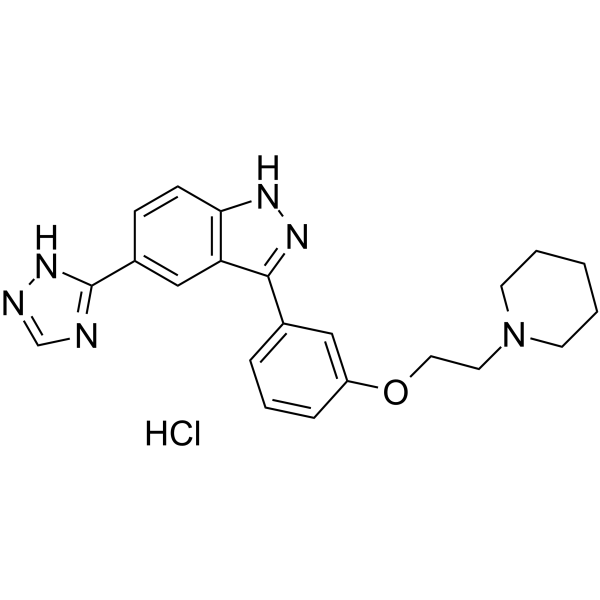上海金畔生物科技有限公司为生命科学和医药研发人员提供生物活性分子抑制剂、激动剂、特异性抑制剂、化合物库、重组蛋白,专注于信号通路和疾病研究领域。
CC-401 hydrochloride (Synonyms: CC401 HCl) 纯度: 99.46%
CC-401 hydrochloride 是一种有效的 JNK 抑制剂,Ki 为 25 到 50 nM。

CC-401 hydrochloride Chemical Structure
CAS No. : 1438391-30-0
| 规格 | 价格 | 是否有货 | 数量 |
|---|---|---|---|
| Free Sample (0.1-0.5 mg) | Apply now | ||
| 10 mM * 1 mL in DMSO | ¥1304 | In-stock | |
| 2 mg | ¥930 | In-stock | |
| 5 mg | ¥1395 | In-stock | |
| 10 mg | ¥2511 | In-stock | |
| 50 mg | ¥7440 | In-stock | |
| 100 mg | 询价 | ||
| 200 mg | 询价 |
* Please select Quantity before adding items.
CC-401 hydrochloride 相关产品
•相关化合物库:
- Clinical Compound Library Plus
- Bioactive Compound Library Plus
- Immunology/Inflammation Compound Library
- Kinase Inhibitor Library
- MAPK Compound Library
- Anti-Cancer Compound Library
- Clinical Compound Library
- Reprogramming Compound Library
- Oxygen Sensing Compound Library
- Anti-Parkinson’s Disease Compound Library
- Anti-Obesity Compound Library
- Transcription Factor Targeted Library
- Targeted Diversity Library
| 生物活性 |
CC-401 hydrochloride is a potent inhibitor of all three forms of JNK with Ki of 25 to 50 nM. |
||||||||||||||||
|---|---|---|---|---|---|---|---|---|---|---|---|---|---|---|---|---|---|
| IC50 & Target[1] |
|
||||||||||||||||
| 体外研究 (In Vitro) |
CC-401 has at least 40-fold selectivity for JNK compared with other related kinases, including p38, extracellular signal-regulated kinase (ERK), inhibitor of κB kinase (IKK2), protein kinase C, Lck, zeta-associated protein of 70 kDa (ZAP70). In cell-based assays, 1 to 5 μM CC-401 provides specific JNK inhibition. CC-401, a small molecule that is a specific inhibitor of all three JNK isoforms. CC-401 competitively binds the ATP binding site in JNK, resulting in inhibition of the phosphorylation of the N-terminal activation domain of the transcription factor c-Jun. The specificity of this inhibitor is tested in vitro using osmotic stress of the HK-2 human tubular epithelial cell line. CC-401 inhibits sorbitol-induced phosphorylation of c-Jun in a dosage-dependent manner. However, CC-401 does not prevent sorbitol-induced phosphorylation of JNK, p38, or ERK[1]. 上海金畔生物科技有限公司 has not independently confirmed the accuracy of these methods. They are for reference only. |
||||||||||||||||
| 体内研究 (In Vivo) |
The staining of p-JNK is moderately induced in bevazicumab and Oxaliplatin treatments as compared to control, and in the CC-401-treated samples p-cJun content is significantly lower, consistent with effective JNK inhibition. DNA damage is modestly elevated in combined treatments with CC-401[2]. CC-401 treatment from days 7 to 24 slows the progression of proteinuria, which is significantly reduced compared to the no-treatment and vehicle groups at days 14 and 21. However, there is still an increase in the degree of proteinuria at day 21 in CC-401-treated rats compared to proteinuria at day 5. The vehicle and no-treatment groups developed renal impairment at day 24 as shown by an increase in serum creatinine. This is prevented by CC-401 treatment[3]. 上海金畔生物科技有限公司 has not independently confirmed the accuracy of these methods. They are for reference only. |
||||||||||||||||
| Clinical Trial |
|
||||||||||||||||
| 分子量 |
424.93 |
||||||||||||||||
| Formula |
C22H25ClN6O |
||||||||||||||||
| CAS 号 |
1438391-30-0 |
||||||||||||||||
| 运输条件 |
Room temperature in continental US; may vary elsewhere. |
||||||||||||||||
| 储存方式 |
4°C, sealed storage, away from moisture *In solvent : -80°C, 6 months; -20°C, 1 month (sealed storage, away from moisture) |
||||||||||||||||
| 溶解性数据 |
In Vitro:
DMSO : 100 mg/mL (235.33 mM; Need ultrasonic) H2O : 12.5 mg/mL (29.42 mM; Need ultrasonic) 配制储备液
*
请根据产品在不同溶剂中的溶解度选择合适的溶剂配制储备液;一旦配成溶液,请分装保存,避免反复冻融造成的产品失效。 In Vivo:
请根据您的实验动物和给药方式选择适当的溶解方案。以下溶解方案都请先按照 In Vitro 方式配制澄清的储备液,再依次添加助溶剂: ——为保证实验结果的可靠性,澄清的储备液可以根据储存条件,适当保存;体内实验的工作液,建议您现用现配,当天使用; 以下溶剂前显示的百
|
||||||||||||||||
| 参考文献 |
|
| Cell Assay [1] |
Human HK-2 proximal tubular epithelial cells are cultured in DMEM/F12 media supplemented with 10% FCS, 10 ng/mL EGF, and 10 μg/mL bovine pituitary extract. For Western blot studies, cells are seeded into six-well plates and allowed to adhere overnight, and medium is changed to DMEM/F12 supplemented with only 0.5% FCS for 24 h, by which time cells are confluent. CC-401 is prepared in citric acid (pH 5.5) and added to the confluent cells 1 h before the addition of 300 mM sorbitol, and cells are harvested 30 min later using urea-RIPA buffer. Three experiments are performed, each with two replicates per condition. For ELISA experiments, HK-2 cells are seeded into 24-well plates, allowed to adhere overnight, cultured in DMEM/F12 with 0.5% FCS for 24 h, and then incubated with CC-401 or vehicle for 60 min before stimulation with 1 μM Angiotensin II (AngII). Supernatants are harvested 48 h later and assayed for TGF-β1 content using a commercial ELISA kit. Three experiments are performed, each using six replicates per condition[1]. 上海金畔生物科技有限公司 has not independently confirmed the accuracy of these methods. They are for reference only. |
|---|---|
| Animal Administration [2][3] |
Mice[2] 上海金畔生物科技有限公司 has not independently confirmed the accuracy of these methods. They are for reference only. |
| 参考文献 |
|
所有产品仅用作科学研究或药证申报,我们不为任何个人用途提供产品和服务
